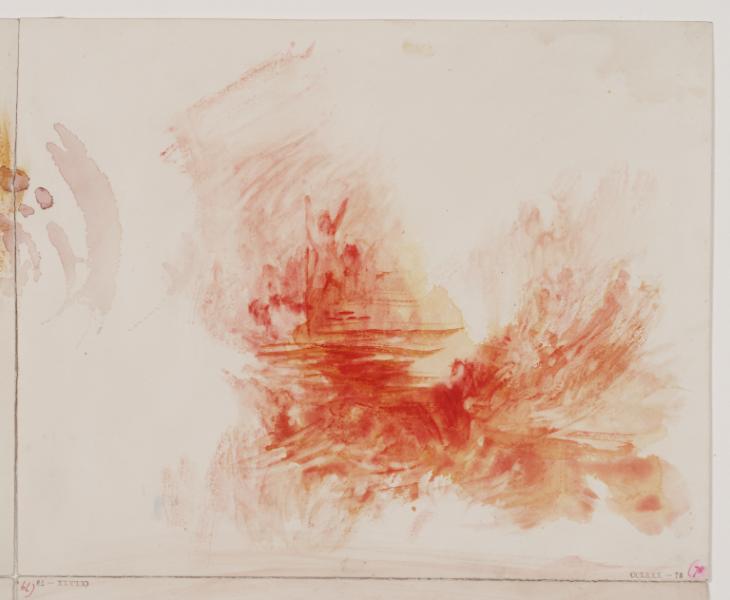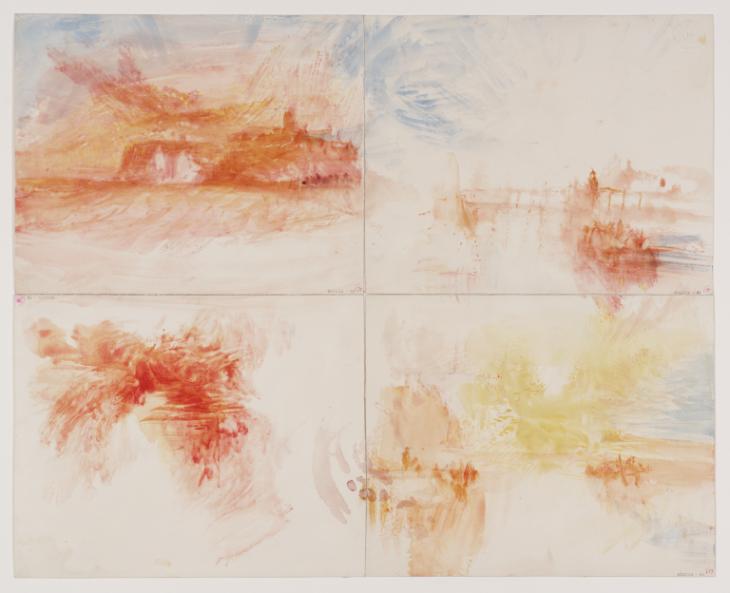Joseph Mallord William Turner ?Study for 'The Angel Standing in the Sun' c.1841-6
Image 1 of 2
Joseph Mallord William Turner,
?Study for 'The Angel Standing in the Sun'
c.1841-6
Joseph Mallord William Turner 1775–1851
?Study for ‘The Angel Standing in the Sun’ c.1841–6
D27595
Turner Bequest CCLXXX 78
Turner Bequest CCLXXX 78
Watercolour on white drawing board, 186 x 230 mm
Blind-stamped with Turner Bequest monogram towards bottom left
Inscribed in red ink ‘(78’ (sic) bottom right
Stamped in black ‘CCLXXX – 78’ bottom right
Blind-stamped with Turner Bequest monogram towards bottom left
Inscribed in red ink ‘(78’ (sic) bottom right
Stamped in black ‘CCLXXX – 78’ bottom right
Accepted by the nation as part of the Turner Bequest 1856
Exhibition history
1992
Turner: The Fifth Decade: Watercolours 1830–1840, Tate Gallery, London, February–May 1992 (53, as ‘Satan Summoning his Legions’, c.1834, reproduced in colour).
1999
Turner’s Later Papers: A Study of the Manufacture, Selection and Use of his Drawing Papers 1820–1851, Tate Gallery, London, March–June 1999 (68, as part of ‘A reassembled sheet made up of four separate works’, after 1841, reproduced in colour, upside down).
2004
Paradise Lost: The Poem and its Illustrators, Dove Cottage and Wordsworth Museum, Grasmere, July–October 2004 (68, as ‘A figure study’, reproduced).
2011
William Turner. Maler der Elemente / Turner and the Elements, Bucerius Kunst Forum, Hamburg, June–September 2011, Muzeum Narodowe, Krakow, October–January 2012, Turner Contemporary, Margate, January–May (74, as ‘A Figure Study, Possibly for “The Angel Standing in the Sun”’, c.1841–5, reproduced in colour).
2014
Late Turner, Tate Britain, London, September 2014–January 2015, J. Paul Getty Museum, Los Angeles, February–May 2015, de Young, Fine Arts Museums of San Francisco, June–September 2015, Art Gallery of Ontario Toronto, October 2015–January 2016 (13, as ‘A Figure Study, possibly for “The Angel Standing in the Sun”’, c.1841–5, reproduced in colour, upside down).
References
1826
A.J. Finberg, A Complete Inventory of the Drawings of the Turner Bequest, London 1909, vol.II, p.895, CCLXXX 78, as ‘Sinai (?)’, c.1826–36.
1830
Andrew Wilton, Turner Watercolours, London 1987, p.112 no.49, as ‘Satan addressing his angels’, c.1830, reproduced in colour p.[113].
1834
Anne Lyles, Turner: The Fifth Decade: Watercolours 1830–1840, exhibition catalogue, Tate Gallery, London 1992, reproduced in colour p.37, p.73 no.53, as ‘Satan Summoning his Legions’, c.1834, reproduced.
1993
Jan Piggott, Turner’s Vignettes, exhibition catalogue, Tate Gallery, London 1993, pp.21, 96 Appendix A.
1999
Peter Bower, Turner’s Later Papers: A Study of the Manufacture, Selection and Use of his Drawing Papers 1820–1851, exhibition catalogue, Tate Gallery, London 1999, reproduced in colour p.70 (upside down), pp.118–19 no.68, as ‘A reassembled sheet made up of four different works’, after 1841, pls.68A ‘transmitted light image of the watermark’ from the present work, 68B (p.72) colour ‘micrograph’ detail of unspecified work, 68C ‘raking light image of the blind-embossed mark’ on D27595.
1834
David Blayney Brown, Turner in the Tate Collection, London 2002, p.145, as ‘Satan Summoning his Legions’, c.1834, pl.100 (colour).
2004
Robert Woof, Howard J.M. Hanley and Stephen Hebron, Paradise Lost: The Poem and its Illustrators, Dove Cottage and Wordsworth Museum, Grasmere, July–October 2004, p.202 no.68, as ‘A figure study’, reproduced p.203.
1841
Amy Concannon in David Blayney Brown, Concannon and Sam Smiles (eds.), Late Turner, exhibition catalogue, Tate Britain, London 2014, p.77 no.13, as ‘A Figure Study, possibly for “The Angel Standing in the Sun”’, c.1841–5, reproduced in colour (upside down).
Finberg’s terse suggestion of ‘Sinai (?)’1 as the subject of this small but powerful figure study perhaps intended the Biblical subject of Moses and the Israelites in the wilderness. Turner made the visionary watercolour vignette Sinai’s Thunder as an illustration to Thomas Campbell’s The Pleasures of Hope (National Galleries of Scotland, Edinburgh),2 engraved for his Poetical Works in 1837 (Tate impression: T04768), with God half-revealed with raised arms amidst cloud and lightning above the throng. Compare also the gesturing spirit and whirling apparition of armed figures in another watercolour vignette, A Tempest, for Samuel Roger’s Voyage of Columbus (Tate D27719; Turner Bequest CCLXXX 202),3 engraved for his Poems in 1834 (Tate impressions: T04677, T05130).
Andrew Wilton suggested the subject of ‘Satan addressing his angels’4 from John Milton’s Paradise Lost and a date of about 1830. Turner provided seven watercolour vignettes to be engraved for an edition of Milton’s Poetical Works published by John Macrone in 1835.5 Among them, with hosts of minute figures painted in strong reds, were The Mustering of the Warrior Angels (Preston Hall Museum, Stockton on Tees)6 from Book V, and The Fall of the Rebel Angels (private collection) from Book VI7 (Tate impressions of the engravings: T06285–T06286). Anne Lyles expanded on Wilton’s suggestion, noting ‘the famous episode in Book One ... when Satan summons his legions on the burning lake’, placing this study at about 1834, and recalling that the episode was ‘the subject of Thomas Lawrence’s diploma picture at the Royal Academy in 1797, for example’, while ‘Turner followed the example of most of his predecessors in depicting Satan with both arms upraised, and adopts an equally heroic pose.’8
Subsequent technical analysis (see the notes below) has shown that the work’s support is in fact watermarked 1841, albeit only on other parts of the larger original sheet from which it was divided, so the subject cannot have been intended for the Macrone edition, as Jan Piggott pointed out.9 Nevertheless the suggestion of the Milton subject has persisted.10 As the technical notes explain, the work was initially one quarter of a sheet, the three others each being used for a coastal landscape in which red is also the predominant colour. Peter Bower has observed that ‘Turner has worked this sheet using a method he used throughout his life, producing four images on the same sheet, only tearing or cutting the individual works apart when they were finished’,11 although as discussed below, the timing of the division is uncertain in this case. Bower noted the impossibility of a direct connection with the 1835 Milton project, but ‘it is possible that such an image would have come to Turner several years after the project was over’ and the four compositions were ‘not studies “for” works as has been supposed, but rather “remembrances” of works already done’,12 in the course of trying out this ‘new paper or even a new brush, using images already deep in him. ... The sheer speed and exuberance of his imagination is unfettered by the scale, the surface or the restricted palette.’13
Assuming Turner was not simply making elaborate, nostalgic ‘doodles’, as it were, Piggott has offered an alternative subject relating to his ongoing work in the 1840s, which has latterly been adopted as perhaps more likely:14 ‘In that the other figures are not in a burning lake but form an ellipse on the right, perhaps [it is] an early study’ for the apocalyptic late painting The Angel Standing in the Sun, exhibited at the Royal Academy in 1846 (Tate N00550).15 There the eponymous winged figure from the Book of Revelation dominates the upper half, brandishing a sword with arms aloft in a vortex of light and energy while various Biblical figures cower in the lower half, in a general arrangement not dissimilar to the Sinai subject first mentioned above.
See also D36120 (Turner Bequest CCCLXIV 273) in the present section for another Biblical subject.
Technical notes:
This sheet’s 1841 manufacture was first published by Jan Piggott, as was its initial physical link with three other pieces of the original support which also remain in the Turner Bequest.1 Paper conservator Peter Bower has since provided a detailed analysis in connection with the mounting of the four quarters together for his Turner’s Later Papers exhibition in 1999. The other three parts are Tate D27596, D27600 and D27602 (Turner Bequest CCLXXX 79, 83, 85), respectively at the top left, bottom right and top right, with the present work at the bottom left, its subject inverted relative to the others.
In its undivided form, the sheet was a ‘Three-ply laminated and glazed white Demy Superfine Drawing board made up of three sheets of white wove drawing paper each measuring 356 x 458’ mm overall.2 A ‘J Whatman | 1841’ watermark was detected ‘once in each of the three sheets that make up the board’, appearing in each of the other quarters, but not here; the paper was made by William Balson & Co. of Springfield Mill, Maidstone, Kent. D27602 carries a blind-embossed mark, ‘EXTRA | SUPERFINE | [crown] | DRAWING | BOARD’.3
As Bower notes, the ‘tearing through a large part of the top left-hand image raises questions as to when, and by whom the sheet was torn down’, whether by Turner ‘or perhaps by Ruskin during his examination of the Bequest’.4
Verso:
Blank; laid down.
Matthew Imms
August 2016
How to cite
Matthew Imms, ‘?Study for ‘The Angel Standing in the Sun’ c.1841–6 by Joseph Mallord William Turner’, catalogue entry, August 2016, in David Blayney Brown (ed.), J.M.W. Turner: Sketchbooks, Drawings and Watercolours, Tate Research Publication, February 2017, https://www


